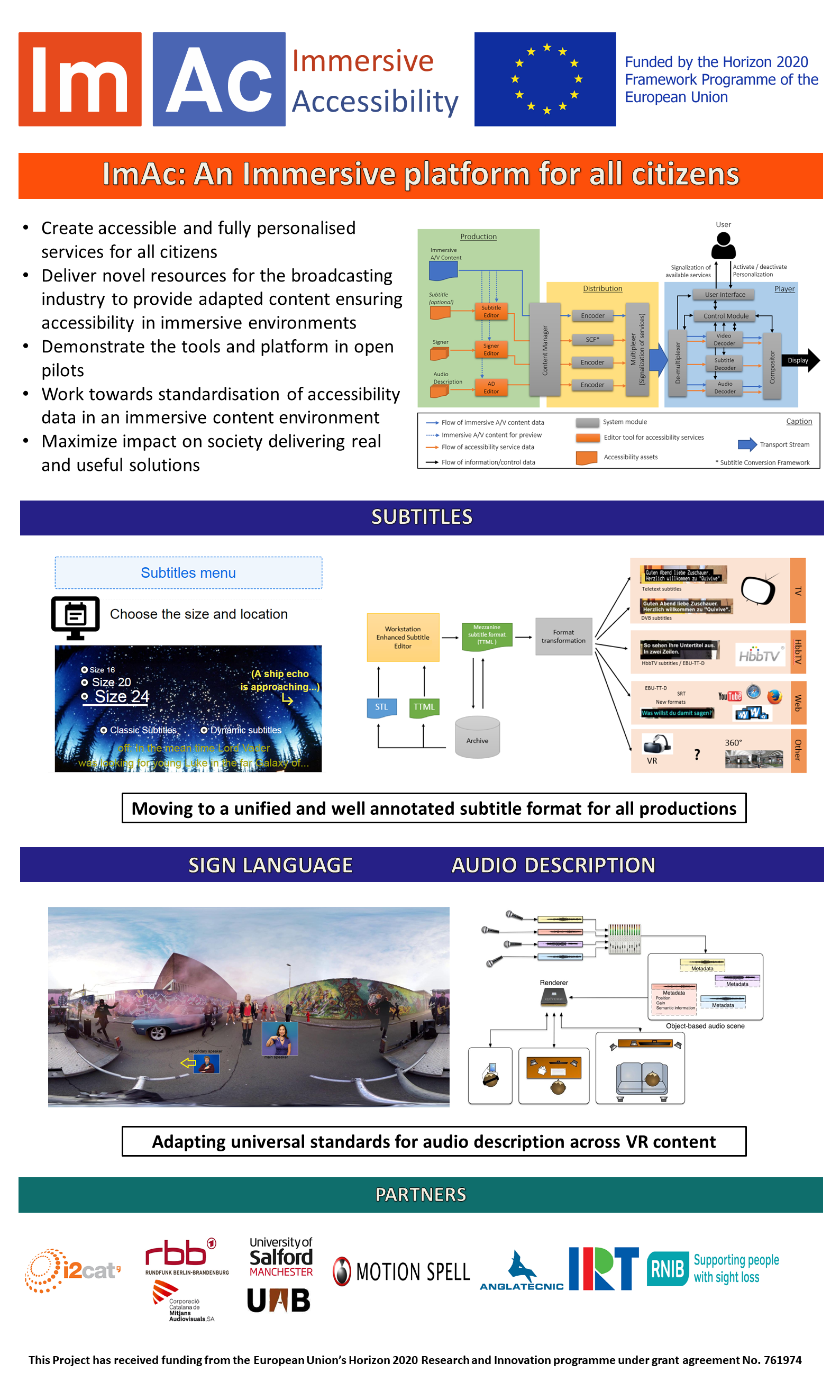
With any new technology it is essential to consider accessibility especially in Europe, where e-inclusion is a priority of the EC and the Single Digital Market. Doing so ensures that the narrative is coherent across languages, ages and abilities, and ensures compliance with regulatory guidelines.
The goal of Immersive Accessibility (ImAc) is to explore how accessibility services can be integrated with immersive media. It is not acceptable that accessibility is regarded as an afterthought: rather it should be considered throughout the design, production and delivery process.
ImAc will explore new deployment methods for these services (Subtitles, Audio Description, Audio Subtitling, Sign Language) in immersive environments. We will move away from the constraints of the current technology, into a Hyper-Personalized environment where the consumer can fully customize the experience to meet his personal needs. For example, it may be more appropriate for subtitles to be read out-loud or the Audio Description presented as text. The key action in ImAc will be to ensure immersive experiences are inclusive across different languages, addressing the needs of those with hearing and low vision problems, learning difficulties and the aged. We also foresee these services consumed by a wider audience, for personal convenience, learning language and language therapy – accessible content can add significant value to these related areas.
Accessibility is generally only considered after a technology has matured to meet the demand of the mass market. This results in a significant barrier to 25% of the EU population with disabilities or age related disabilities. This number is increasing as the ageing process is a shifting demographic trend within Europe. Within the EU the number of people aged 65 or over has increased by 2.3% in the last 10 years4 and also it is estimated that there are currently around 80M citizens with disabilities.
In order to achieve an inclusive society we must consider all people as potential consumers and the incorporation of accessible solutions into new technologies from the start allows their full deployment and exploitation. “Design for users with users” will ensure we meet end-users’ expectations and should lead to a robust and meaningful environment where immersive and pervasive solutions, for an increasingly personalised user experience, are achieved. Providing standards early on will also avoid duplication of work and ensure compatibility between frameworks. The motivation behind ImAc is to design and test the behaviour and possibilities of media access services in the new immersive environments from a user-centric methodology.
Providing cutting-edge technology to all people is essential and promotes inclusion – an important social policy in Europe where “united in diversity” is the official motto. This project will exploit the immersive technology which lends itself to a hyper-personalisation, increasing the participation of old and new EU citizens and residents in the new media landscape. By bringing together: technologies, content creators and distributors, along with end-users will result in new business models and opportunities. Offering the creative industries tested services and new ways of interaction should pave the way to a stronger EU media sector reaching to new and wider audiences. Using and exploiting technology to its best, and considering EU diversity, should provide robust solutions which can later be exploited worldwide, positioning Europe as one of the world leaders in Media Accessibility. Innovations in this project will work towards a connected Digital Single Market where individuals and businesses can seamlessly access and experience media content under the same conditions of fair competition irrespective of their nationality, disability or age.
ImAc will be a prototyping platform where end-users with special needs will be able to define from the start what services they need and how they want it, following a user-centric design. The project will match these expectations to what is possible with current and future technologies and having an open dialogue between end-user and technology developers is crucial for a meaningful development and technology deployment.
The immersive technology opens the door for many people, who may benefit from the services developed from this work which goes beyond consuming traditional television. Empowering disabled users by enabling them to directly control immersive media and interact with the environment themselves, can boost user confidence and lead to greater autonomy. For all those users with special needs, an accessible platform will be created that will facilitate navigation and consumption of all immersive content, and selection and operation of inclusive services (such as subtitling and enhanced audio) in a user-friendly way. This platform opens the door for the development of future services which will no doubt improve quality of life for those with mobility or communication restrictions.
Opening immersive worlds to EU industry
ImAc will demonstrate that there is a place in the market for accessible immersive content, for both industry and society. In order to demonstrate feasibility, accessibility must be considered from the beginning of the design process in order to provide a high-quality service, which really answers the needs of users and ensures a maximum level of QoE.
New job opportunities are being created by the immersive technology industry, where immersive content is at the heart of the training, production and monetisation for many EU media industries.
Immersive content can deliver significant benefits in education where primary/secondary schools across countries can join in collaborative learning and follow a joint curriculum, which can be developed and consumed across borders. This can lead to seamlessly triggered language learning beyond Google Yuriana, or as shown in the EU funded project IMARECULTURE. These collaborative, accessible, and multilingual learning environments can change EU education promoting cohesion and establishing links. School exchanges under ERASMUS programmes will also benefit, complementing existing exchange programmes and accelerating integration. Existing education environments where immersive technology has been shown to be successful include the car industry, e-Health training (such as the EU funded project AUGGMED), and dancing (WhoLoDance).
ImAc will also offer a response to the creative media industry within in the broadcast sector, creating new and innovative ways to engage and empower audiences. Demonstrating quality-tested techniques for adding accessible content into these immersive environments helps move towards the Digital Single Market. ImAc will guarantee one of the “four freedoms” since immersive services will be multi-language and accessible across borders. Helping to overcome communication barriers will also promote the development of common policies on product regulation and freedom of movement for production, something very much at the heart of ImAc and the interest in standardisation. ImAc shares the vision of “A Connected Digital Single Market” avoiding duplication of effort, promoting quality interaction and with end-users at the heart, allowing for new innovative solutions.
- Create accessible and fully personalised services for all citizens
- Deliver novel resources for the broadcasting industry to provide adapted content ensuring accessibility in immersive environments
- Demonstrate the tools and platform in open pilots
- Work towards standardisation of accessibility data in an immersive content environment
- Maximize impact on society delivering real and useful solutions

Partners
- i2CAT Foundation (Spain)
- Rundfunk Berlin-Brandenburg (Germany)
- University of Salford (UK)
- Corporació Catalana de Mitjans Audiovisuals, S.A. (Spain)
- Motion Spell (France)
- Universitat Autònoma de Barcelona (Spain)
- Anglatècnic (Spain)
- Institut für Rundfunktechnik GmbH (Germany)
- Royal National Institute of the Blind (UK)
This project has received funding from the European Union’s Horizon 2020 research and innovation programme under grant agreement No 761974


